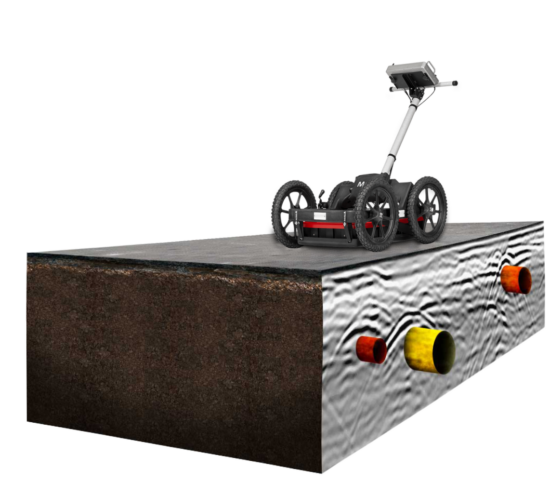As a world leader in geo-technology, Guideline Geo and MALÅ is the perfect partner for your ground penetrating radar (GPR) solution needs. MALÅ has a history of high-tech innovation going back to the 1930´s and is the premier provider of GPR control units, antennas, software, and accessories around the world.
We also offer support, training and rental options for all systems and equipment so you can focus completely on the planning and execution of your project. We combine service and knowledge with world-leading geophysical solutions.
GPR Method
Ground penetrating radar (GPR) is a non-destructive and rapid geophysical method that operates by transmitting electromagnetic waves form an antenna and reflects off layers and objects hidden in the ground. A typical ground penetrating radar system consists of one or more antenna elements, a control unit, an external Tablet/PC or a monitor, for storage and display of data. Ground penetrating radar offers an efficient way of investigating both the ground and constructions, with user-friendly one-man operated equipment. Depending on the application, you have a large selection of different MALÅ GPR solutions to choose from which will solve your investigation needs, both in terms of antenna frequency and number of data channels.
GPR Applications
GPR have a very wide range of applications, from measurements of the subsurface to investigations of constructions. The most common applications are:
- Utilities
- Concrete investigations
- Roads and Railways
- Archaeology
- Geology
- Water
|
- Earth and concrete dams
- Tunnels and mining
- Environmental
- Military
- Ice and snow
|
MALÅ geophysical products
The MALÅ range of products facilitates the mapping of everything from shallow rebars to investigations of hundreds of meters of ice.
MALÅ Easy Locator Core is the state-of-the-art intelligent GPR solution for utility locating professionals. It offers a seamless workflow from the field to the office, through the easy-to-use software solutions MALÅ Controller App and MALÅ Vision.
MALÅ Ground Explorer (GX) is an integrated GPR solution with a wide range of antenna options and measuring devices. It is wireless and works with the MALÅ Controller App or a dedicated data collection field controller.
MALÅ MIRA HDR is a 3D GPR array for cost-effective mapping of large areas to locate buried objects and features. The system is ultra-fast and delivers high-density razor-sharp data.
MALÅ Easy Locator WideRange is, with its dual channel antenna, the go-to choice for both shallow high-resolution surveys and deep utility locating projects.
MALÅ GeoDrone is an airborne GPR solutions for efficient field work, designed specifically for data collection in remote hazardous and inaccessible areas.
MALÅ MIRA is a 3D GPR array providing a cost-effective solution for large-scale mapping and subsurface object identification.
MALÅ ProEx is fully compatible with a broad range of MALÅ GPR antennas and offers a flexible and very versatile GPR solution from concrete investigations to deep geological and glaciological investigations.
MALÅ Concrete Explorer (CX) is an easy-to-use GPR system designed for concrete investigations and non-destructive imaging of man-made structures.
Contact us to get a quote
If you have any questions, you are always welcome to contact our customer service or get in touch with our 24/7 sales support. We want to be close to you as a customer and therefore we aim to respond as soon as possible. Get in touch with our dedicated Global Sales and Applications support teams by filling out the webpage contact form.





